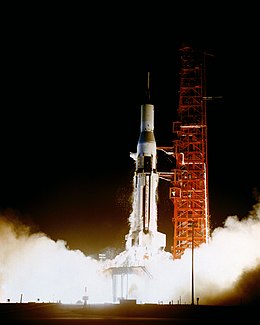 Launch of Saturn AS-104 | |
| Mission type | Spacecraft aerodynamics; micrometeoroid investigation |
|---|---|
| Operator | NASA |
| COSPAR ID | 1965-039B |
| SATCAT no. | 1385 |
| Mission duration | 8,810 days[1] |
| Distance travelled | 3,282,050,195 kilometers (2.039371443×109 mi) |
| Orbits completed | ~79,790 |
| Spacecraft properties | |
| Spacecraft | Apollo BP-26 Pegasus 2 |
| Launch mass | 1,451.5 kilograms (3,200 lb) |
| Start of mission | |
| Launch date | May 25, 1965, 07:35:01 UTC |
| Rocket | Saturn I SA-8 |
| Launch site | Cape Kennedy LC-37B |
| End of mission | |
| Decay date | July 8, 1989[1] |
| Orbital parameters | |
| Reference system | Geocentric |
| Regime | Low Earth orbit |
| Perigee altitude | 511 kilometers (318 mi) |
| Apogee altitude | 739 kilometers (459 mi) |
| Inclination | 31.7 degrees |
| Period | 97.2 minutes |
| Epoch | 4 July 1965[2] |
AS-104 was the fourth orbital test of a boilerplate Apollo spacecraft, and the second flight of the Pegasus micrometeoroid detection satellite. It was launched by SA-8, the ninth Saturn I carrier rocket.
- ^ a b "Apollo Model 4". n2yo.com. Retrieved February 3, 2023.
- ^ McDowell, Jonathan. "Satellite Catalog". Jonathan's Space Page. Retrieved October 31, 2013.